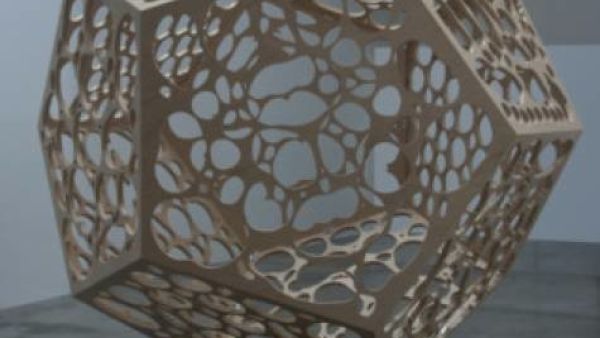Ever since their stomping rise onto the international arena, media outlets have touted Qataris as profligate spenders of their seemingly boundless natural resource wealth. From popular retail outlets to professional sports teams and other highly lucrative sectors, the Qatar Investment Authority seems to have its crosshairs locked on a myriad of potential ventures, all of which are currently worth over $115 billion.
On the mounted whiteboards inside the QIA’s headquarters in Doha – where investment ideas begin their incipiency and gradually evolve into another subsection of the Fund’s portfolio – one particular item seems to stand out: artworks.
Art is not necessarily what many financial experts would categorize as a high-yield investment worthy of a petrodollar purchase. However, Sheikha Al Mayassa Bint Hamad bin Khalifa Al Thani would staunchly disagree. The sister of the newly appointed Emir of Qatar, Sheikh Tamim, has emerged onto the arts scene with quite the vengeance. For a single fiscal year, it has been estimated that the Sheikha allocates approximately $1 billion a year for purchasing one-of-a-kind art pieces from all corners of the globe.
That is over thirty one times more than the Museum of Modern Art in New York City spent on artworks in 2012.
The Sheikha, staying true to trends in the region, has also set a new record for the highest price ever paid for a painting. Her purchase of Cézanne’s “Card Players” cost the Qatar Museums Authority, the entity she heads and is investing on behalf of, approximately $250 million.
Other rising cultural hubs in the region, such as the United Arab Emirates, have also been blitzing the global art community. Emirati authorities have recently confirmed the continuation of numerous stalled megaprojects, including the Guggenheim Abu Dhabi (2017), the Zayed National Museum (2016) and the construction of the highly anticipated Louvre Abu Dhabi (2014). As an extension of the institution in Paris, it has been reported that Emirati authorities have paid approximately $520 million to use the Louvre name, in addition to $747 million for consultations and art loans. Those figures are not even inclusive of the $660 million construction costs. This ultimately begs the question: will such an investment pay off?
The answer is not as clear-cut as one may presume. An investment in art is an injection of liquidity into the cultural sector of the economy, which is the ultimate goal of bodies like the Qatar Museums Authority and the Tourism & Development Investment Company. Said sector encompasses a range of valuable and, at times, highly productive industries, including publishing, performance arts and visual arts. The industry provides jobs that require a technical ability as well as a creative one, recruiting individuals from various backgrounds - albeit on a modest scale.
This creative aspect cannot be underestimated in terms of the vitality it provides to the marketplace. With such rich cultures and customs in this part of the world, an investment in the arts is equivalent in nature to an investment in tourism. As more music festivals, theatrical performances and museum openings take place in the Middle East, their immediate economic footprints are distinctly outlined for all to see. However, an equally, if not more, significant contribution to the market comes in the form of an economic spillover.
Policymakers are not blind to this concept. It was part of the motivation for President Hollande’s administration when they suggested imposing a 4% value-added tax on the sale of smartphones and tablets. This so-dubbed “culture tax” would funnel a portion of its revenues towards funding the French arts sector. Aside from crystallizing the sustenance of the culture industry as a top priority of the government, policymakers in France and beyond are planning on tapping into the benefits of what is called a Keynesian multiplier effect.
In layman’s terms, any spending committed to the arts, such as the Sheikha’s $1 billion or some of the upcoming megaprojects in the region, will translate into additional subsequent cycles of spending. These can range from hotel room reservations, which benefit the hospitality sector, to car rentals, retail shopping and fully booked restaurants. Art connoisseurs and tourists alike will spend their income in markets that are secondary to the museum, gallery or theater they were basing their original itinerary on. All in all, it seems like everybody wins.
At first glance, the investment, be it from public tax funds or private sources, seems impervious to any form of risk, especially given the multiple layers of payoffs. An in-depth economic impact analysis, however, will reveal that these benefits may be overvalued.
Initially, direct spending, which constitutes the actual investment into the art sector, is measured in gross terms. The indirect investment, however, is more intricate and comes with an extensive list of caveats. For example, if those visiting the museums to appreciate the artwork or purchasing tickets to see the performance are local residents, then the transactions are simply re-injections within the economy. The multiplier effect then serves to arbitrarily bloat the valuation of the sector, creating a redundant cycle of the same money exchanging hands repeatedly.
When investing in the national cultural industry, the key targets have to be sources of revenue that are considered legitimately original additions to spending. In other words, the sector’s employees who use their income to dine at a local restaurant are generally not considered value-added contributions that stem from the arts sector. In order for such an investment to pay off as advertised is to attach an aggressive marketing campaign to it – one that transcends the community’s borders. Thus we find the role that campaigns like“Malaysia, Truly Asia” and “Dubai: The Center of Now” play in attracting these revenues.
Eventually, in addition to providing employment and encouraging creativity, increasing gross domestic income without the help of loans or petroleum is a policy that would be difficult to refute. But when it comes to evaluating whether or not an investment of this nature will generate favorable returns, a financial analysis is not sufficient. The social return on the investment, in addition to the spillovers and intrinsic benefits, is where the real value materializes.
By: Bassem Auon
Bassam Aoun is currently based in Abu Dhabi and holds a BA in Economics from the American University of Beirut and an MPP (Master of Public Policy) from the University of Chicago. He has written for the Chicago Policy Review and is interested in economic and fiscal policy in the Middle East.








